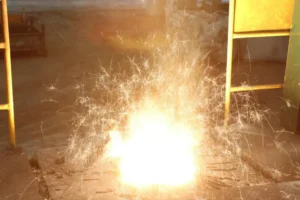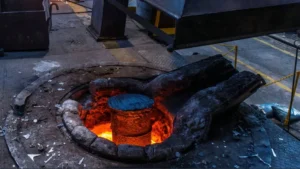Di sini adalah “Panduan Utama Pengoperasian Tungku Induksi yang Aman: 10 Aturan Emas,” meticulously compiled to help all operators internalize safety awareness as a operational instinct.
Golden Rule 1: The PPE & Qualification Rule
“People” are the first line of defense for safety.
- Certified Operation: Untrained or uncertified personnel are strictly prohibited from operating induction furnaces. All operators must pass professional safety and operational training.
- Full Protective Gear: When working in front of the furnace (pengisian daya, taking temperatures, contoh, terak, penyadapan), it is mandatory to wear a full set of personal protective equipment (APD): flame-retardant and heat-resistant clothing, a safety helmet, a professional face shield (protecting against intense light and heat radiation), insulated gloves, and heat-insulated safety boots.
Golden Rule 2: The Pre-Start Tri-Check
Pre-start checks are critical to preventing major accidents.
- Memeriksa “Air” (The Lifeline): Inspect the cooling water system. Ensure water pressure, flow rate, and temperature are all within the normal range. Cooling water is the lifeline of the induction furnace; interruption or leakage is a primary cause of coil burnout and lining damage.
- Memeriksa “Kekuatan”: Inspect the insulation of the power cabinet, kabel, and induction coil. Ensure there is no exposed wiring, no loose connections, and that the system is well-grounded.
- Memeriksa “Lapisan”: Visually inspect the furnace lining. New linings must be strictly sintered (kering) according to the proper heating curve. Old linings must be inspected for cracks, erosi, atau “red spot” bahaya.
Golden Rule 3: Itu “Zero Moisture” Rule
Ini adalah “Cardinal Rule” of induction furnace safety and the number one priority for preventing explosions!
- Absolutely Dry Charge: Strictly prohibit adding damp, wet, snowy, or icy charge materials (baja bekas, kembali) into the furnace.
- Absolutely Dry Tools: Any tools inserted into the furnace (such as slag rakes, temperature probes, or samplers) must be preheated and completely dry.
- The Consequence: When wet, cold objects contact high-temperature molten metal, they instantly vaporize, causing a “steam explosion.” The force is powerful enough to blast the multi-ton furnace lid and molten metal out of the furnace.
Golden Rule 4: Itu “No Sealed Items” Rule
Never guess what you are charging.
- Inspect Charge Material: Strictly prohibit charging sealed containers (MISALNYA., unopened pipes, paint cans, gas cylinders) or any items suspected of being explosive (MISALNYA., ammunition) into the furnace.
- The Consequence: Sealed containers will experience a massive internal pressure increase at high temperatures, leading to a physical explosion.
Golden Rule 5: The Smart Charging Rule
Improper charging methods are a common cause of lining damage.
- No Smashing: When there is no molten pool at the bottom, do not drop heavy, large blocks of material (like iron ingots) directly onto the furnace bottom. This can easily damage the lining. Lighter, thinner materials or small pieces should be added first as a cushion.
- Prevent “Bridging“: Ensure the charge material can melt down smoothly. If the material “jembatan” (yaitu, the upper material is stuck while the material below is molten), it must be handled carefully with the power OFF to prevent a sudden collapse, which can cause molten metal to splash.
Golden Rule 6: Itu “Look-Listen-Observe” Rule
A furnace “talks” when it’s running; you must learn to listen.
- Look (at the Shell): Periodically patrol and inspect the furnace shell during melting. If a “red spot” or glowing area appears on the shell (especially near the induction coil), this is an extremely dangerous signal that the lining is about to fail! The furnace must be shut down immediately for repair.
- Listen (to Sounds): Listen to the sounds from the power cabinet and furnace body. Abnormal electrical discharge sounds or dull “humming” may indicate an electrical fault or a lining problem.
- Observe (the Gauges): Closely monitor all instrument readings: suhu air, tekanan air, saat ini, voltage, dll.. Any abnormal fluctuations must be investigated immediately.
Golden Rule 7: The Slagging & Temp Safety Rule
These are two procedures where burn injuries are extremely common.
- Use Dry Tools: We re-emphasize: slagging tools must be dry.
- Prevent Splashing: Move gently when removing slag to avoid pulling out and splashing molten metal.
- Temperature Check Protection: The face shield must be worn properly during temperature checks to protect against any metal splashes caused by “boiling” or reactions.
Golden Rule 8: The Tapping Zone Rule
Penyadapan (penuangan) is a transfer of risk.
- Zone Must Be “Clear”: Ensure the tapping pit (if one exists) and the pouring area are free of obstacles and unauthorized personnel.
- Zone Must Be “Dry”: Ensure the tapping pit, launder (trough), and floor are absolutely dry. Water in the pit is a major hazard during tapping.
- Ladle Must Be “Hot”: The ladle receiving the molten metal must be preheated to the specified temperature (usually a bright red) according to regulations. This removes all moisture and prevents “chilling” from a large temperature difference.
Golden Rule 9: The Smooth Tapping Rule
Steadiness is the core of the tapping operation.
- Tilt Smoothly: The action of tilting the furnace must be steady, slow, and controlled. If two people are operating, commands must be clear and teamwork must be synchronized.
- Do Not Overfill: The molten metal ladle should not be filled past 80% of its capacity. This prevents spillage during transport and pouring.
- Prompt Return: After tapping is complete, the furnace should be returned to its upright position as soon as possible to prevent the lining from being exposed and cooling excessively.
Golden Rule 10: The Emergency Plan Rule
When an accident happens, the correct reaction can save lives.
- Know Where: All operators must know the location of all “Emergency Stop” tombol.
- Know How: Operators must be proficient in the emergency procedures for “water leaks,” “furnace lining penetration,” Dan “power loss.”
- Lining Penetration / Water Leak Procedure: If a lining breakthrough or serious water leak is discovered, the first priority is human safety. Immediately cut all power. Based on the situation (MISALNYA., whether molten metal has contacted the coil), execute the procedure for emptying the furnace or emergency cooling.
Kesimpulan: Safety is a Non-Negotiable Bottom Line
An induction furnace is not ordinary equipment; it handles molten metal at thousands of degrees. These 10 Golden Rules are not “suggestions”—they are “commands” that must be executed. Any compromise on procedure can lead to irreversible consequences.
Respect for life and respect for procedure is the highest duty of every furnace operator.







